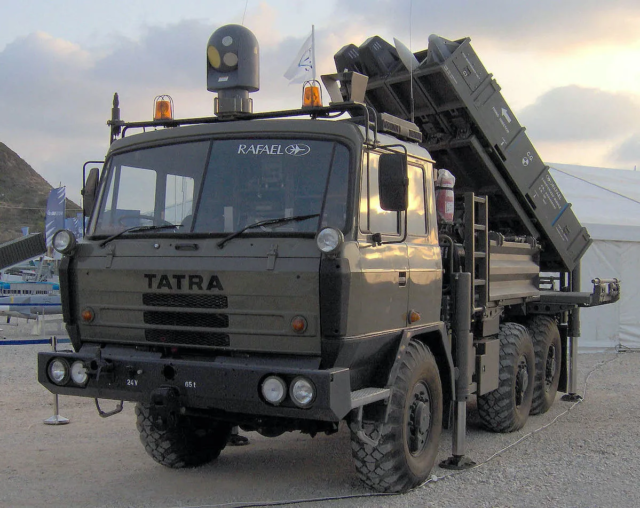During Israeli President Isaac Herzog’s visit to the United Arab Emirates (UAE) on January 30, Houthi rebel forces in Yemen provocatively launched a ballistic missile at Dubai. US armed forces fired Patriot missiles at the incoming missile but apparently did not hit it. Pentagon press secretary John Kirby later said it was Emirati surface-to-air missiles that actually engaged the targets.
With what? Initial reports said the Emiratis operated a South Korean system but the South Korean sale was only signed in January. The UAE has a short-range Skyknight system, a key component of Rheinmetall’s Skynex air defense system, that is produced in-country, as well as the Russian Pantsir-s1s medium-range air defense system and THAAD, but if any of these were used that would have been stated as in the past.
In particular, if it was the Pantsir that took out the Houthi missile, it would have given bragging rights to the Russians.
However, speculate for a moment on the possibility that it was an Israeli system operating undercover. The visit of Israel’s president was a major diplomatic event in a place squeezed between a hostile Iran and its belligerent Houthi proxy force in Yemen. The potential security nightmare might reasonably have prompted Israel to send its own force to protect President Herzog in Dubai. Israeli Prime Minister Naftali Bennett had, in fact, offered the UAE “security and intelligence support” after an earlier attack.
The Houthis say they targeted the al-Dhafra airbase situated about 32 kilometers south of Abu Dhabi and operated by the United Arab Emirates Air Force. That base also hosts the US Air Force 380th Air Expeditionary Wing, home to approximately 2,000 American military and civilian-military personnel operating fighter and surveillance aircraft including AWACS and UAVs.
A Spate of Attacks
It was the third time in recent weeks that US troops were forced into their bunkers. On January 17, the Houthis hit a fuel depot in Abu Dhabi, killing three people. On January 24, there was a missile attack on Al-Dhafra, after which US Central Command reported that American and UAE armed forces “combined successfully” and “prevented both missiles from impacting the base.”
The most recent attack was, likely by a Zulfiqar or Dezful missile. These are solid fuel rockets evolved from the Iranian Fateh-110 which are built in Iran with parts supplied by China. Newer versions have extended the projectile’s range and improved its guidance systems. Iran ships them partially disassembled to Yemen where technicians, most likely Iranians, reassemble them and set up launch platforms.
It is unclear whether the US or the Emiratis fired first at the Houthi missile but it is clear that the two air defense systems were not coordinated – normally they are. That would make sense if the Emirati system was secretly – and/or temporarily – deployed for the President’s visit.
Many of the top Israeli air defense systems, ranging from Iron Dome, David’s Sling and Arrow, were co-developed with the US. For Israel to export any of these systems, US export licenses would be needed and – so far as is known – none have been issued. This leaves only two other major Israeli air defense systems, namely Spyder and Barak, that could be exported, as they are entirely based on indigenous technology.
During his visit, President Herzog is known to have discussed possible sales of Israeli systems to the Emirates, and that the UAE had specifically raised the possibility of the Barak missile. Barak is a product of Israel Aerospace Industries (IAI) and is in production with India as the Barak-8. It has also been exported to Azerbaijan, where it successfully intercepted a Russian-made Iskandar ballistic missile during the Nagorno-Karabakh war.
Ballistic Targets
Iskandar is a short-range ballistic missile with a speed of about Mach 5.9 – putting it at the low end of a hypersonic missile. IAI’s CEO Boaz Levy says the Barak Extended Range (Barak ER) system, which has a range of about 150 kilometers, was designed “in particular against ballistic targets.”
However, the export of Israel’s core air defense systems presents a problem for Israel because it wants to protect the integrity of its deterrent. In fact, elements of Israel’s security establishment were opposed to a potential sale of Iron Dome to the UAE because many of the components and much of the software are interchangeable with higher-end systems.
This is not so much the case with Barak or Spyder, neither of which is considered part of Israel’s increasingly integrated air defense system. It would thus make sense that it was a Barak ER that knocked out the Houthi-fired missile as IAI and Israel’s Defense Ministry tested the system extensively against ballistic targets for just this kind of mission.
Remember, this is entirely speculation.
But although it is, it may be that Israel went to great lengths to protect its president and the diplomatic mission he undertook. Indeed, following the attack, Israel announced it would engage in discussions with the UAE for air defense systems, including Iron Dome.






